ORDER
Passeriformes
• FAMILY •
Parulidae
GENUS & SPECIES
Geothlypis trichas
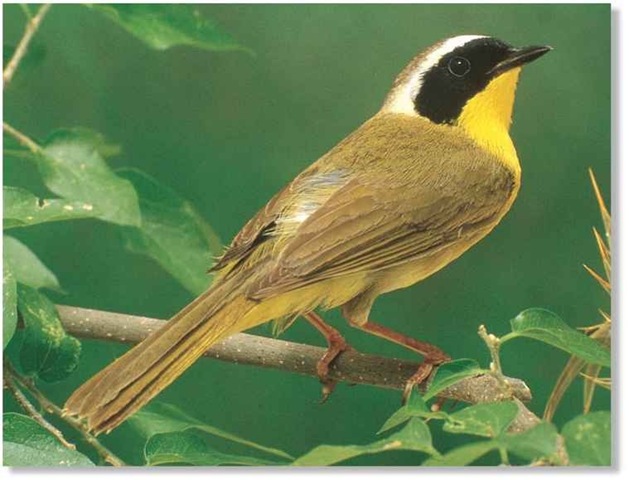
key features
• Feeds and nests on or near the ground, rarely ascending to a tree or bush higher than 5′
• Despite its preference for the ground, flies high in the sky during spring and fall migrations
• Male birds are easily distinguished from female birds by their broad, black mask
where in the world?
Breeds from Alaska to the Gulf of Mexico; winters from California and North Carolina to the Bahamas, Cuba, Mexico and Central America
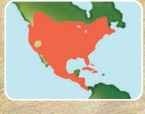
Lifecycle
The common yellowthroat leads a secret life; the male masquerades with its black mask while the female remains well hidden, carefully protecting her clutch.
HABITAT
The common yellowthroat is perhaps the most widespread American wood warbler It breeds in all 49 of the mainland states in the U.S. and in all of Canada’s provinces and territories. Summer and winter haunts are similar, with the yellowthroat preferring damp, brushy habitats, including marshes, cattail meadows, brambles and bogs. In the drier regions of the western U.S., the bird occurs mainly in marshy stream and pond margins and flooded thickets. Rarely seen in gardens or backyards,the main requirement of the T Peaceful perch common yellowthroat’s home is A yellowthroat enjoys the view from atop a bramble. thick cover nearby
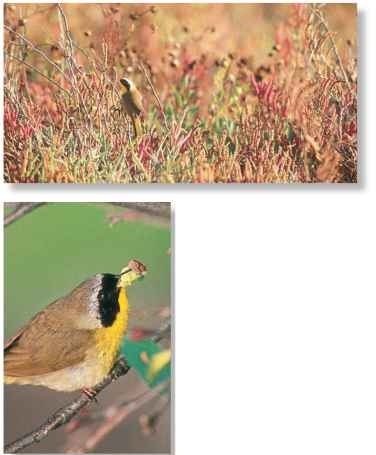
FOOD & FEEDING
The common yellowthroat forages for an extremely wide range of insects while crouched low in vegetation or on the ground. This equal-opportunity hunter targets everything from dragonflies, grasshoppers, moths and leafhoppers, to damselflies, mayflies and butterflies. The bird also gleans spiders, beetles, grubs, cankerworms and caterpillars from leaves and grasses. The yellowthroat carefully works its way through the dense tangles of its preferred habitat, often perching and climbing on the tall vertical stalks of nearby reeds or rushes while searching for a wide variety of food.
Lunch time
A common yellowthroat takes time out to enjoy a quick snack.
BREEDING -
Beginning in March, males start to arrive at their northern breeding grounds. Territories are established before females arrive, and the males’ songs resound across the U.S. and Canada, advertising their presence to the arriving females. The males’ courtship displays include postures and aerial maneuvers designed to show off their sleek, black masks. The bulky nest is constructed from grasses, leaves and bark; it is then lined with fine grasses and hairs. The pair builds the nest on or near the ground, at the base of a bush or in a clump of weeds (usually no higher than 5′ above ground).The female lays 3-5 glossy white eggs with dark specks, lines or blotches, and she incubates them alone for about 12 days. Both parents feed insects to nestlings, and the young birds grow rather quickly; they are ready to fly in 10 days. But since the nest is on or near the ground, they often fall prey to snakes and small mammals.
PARENTS AT WORK
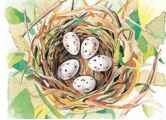
1 multitude…
A female yellowthroat has finished laying her clutch of five speckled eggs inside the bulky, cup-shaped nest.
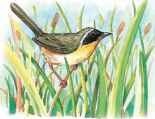
2 Solitude…
A male yellowthroat perches high on a reed stem overlooking the marsh, keeping a close watch for intruders that might pose a threat.
CONSERVATION
Widespread across much of North America, the common yellowthroat is not currently globally threatened.The gradual loss of its wetland habitat, however, including drainage of swamps for various purposes, could ultimately affect its long-term success.
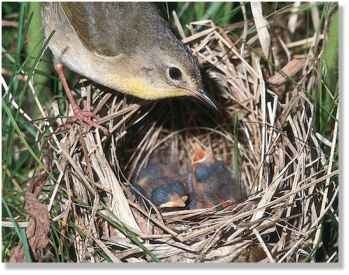
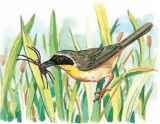
3 Baby food…
One parent snatches a spider from the head of a bulrush, expertly capturing a high-protein snack for its hungry young.
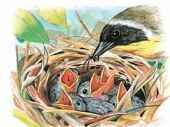
4 Gratitude
The fast-growing nestlings, with mouths agape, are anxiously awaiting their next meal from their dutiful parent.
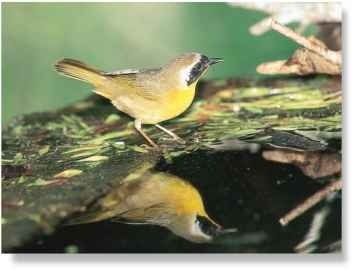
# Subspecies of the common yellowthroat include the Maryland, the Florida and the tule yellowthroats, with the Maryland name used as a universal label for these birds by birdwatchers.
The yellowthroat’s genus name comes from the Greek words, ge, meaning earth, and thlypis, a kind of finch — hence the genus name means, quite literally, a ground bird.
BEHAVIOR
The male common yellowthroat is a masked bandit, moving with secrecy through the dense vegetation of its home.To avoid threats, both sexes skulk low in the dense underbrush. But when intruder enters their territory the wary birds utter their startling alarm note, a loud tsip, emerge from cover; curiously peer around and then quickly retreat back out of sight. In spring, the males can be quite conspicuous, singing their bright witchery, witchery, witchery call to advertise their presence. From March to May the birds arrive in the northernmost reaches of their range, returning south from mid-August to late October Because the common yellowthroats are night migrants, many of the birds collide with tall structures, including power stations and lighthouses, as they fly to and from their summer homes.
Sensational singers When not hunting quietly (left), the talented common yellowthroat emits a wide variety of calls ranging from mating calls to alarm calls (right).
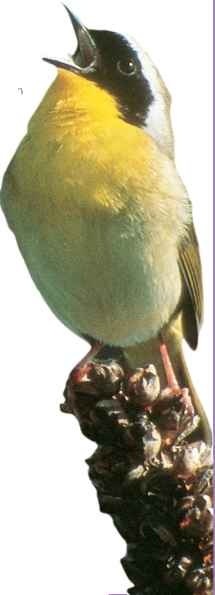
Profile
Common Yellowthroat
The energetic and lively common yellowthroat, with its distinct golden neck feathers, makes a lasting impression throughout its range.
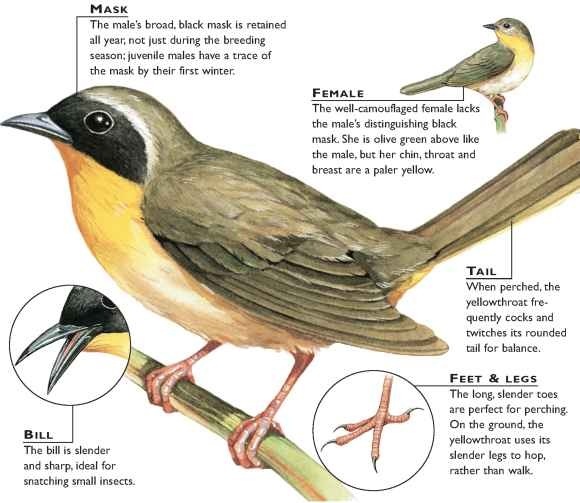
CREATURE COMPARISONS
The Bahama yellowthroat (Geothlypis rostrata), measuring up to 6″, is slightly larger than the common yellowthroat. Males of both species boast the conspicuous black mask, but the Bahama yellowthroat lacks the extensive gray border around the mask and has a yellow belly in contrast to the common yellowthroat’s whitish one. Both species feed on insects, but the Bahama yellowthroat uses its larger and heavier bill to catch anole lizards as well. While the widespread common yellowthroat frequents marshes and wet scrub, the Bahama yellowthroat, limited to the Bahamas, prefers pine woodlands and hardwood thickets.
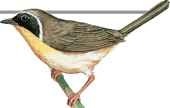
Common yellowthroat

Bahama yellowthroat
| vital statistics | |
| Weight | 0.25-0.5 oz. |
| Length | 4.5-5.5″ |
| Sexual Maturity | About 1 year |
| Breeding Season | April-July |
| Number : of Eggs | 3-5 |
| Incubation t Period | 12 days |
| Fledging W Period | 10 days |
| Breeding Interval | Up to 2 broods per season |
| ( Typical | Diet | Mainly insects, including grasshoppers, beetles, flies and ants |
| Lifespan | Over 6 years |
Related species
• The yellowthroat is 1 of about 12 species in the genus Geothlypis, which includes the Belding’s yellowthroat, G. beldingi, and the gray-crowned yellowthroat, G. policephala. These birds are among over 100 species of American wood warblers in the family Parulidae, including the largest North American wood warbler, the 7.5″ long yellow-breasted chat, Icteria virens.
